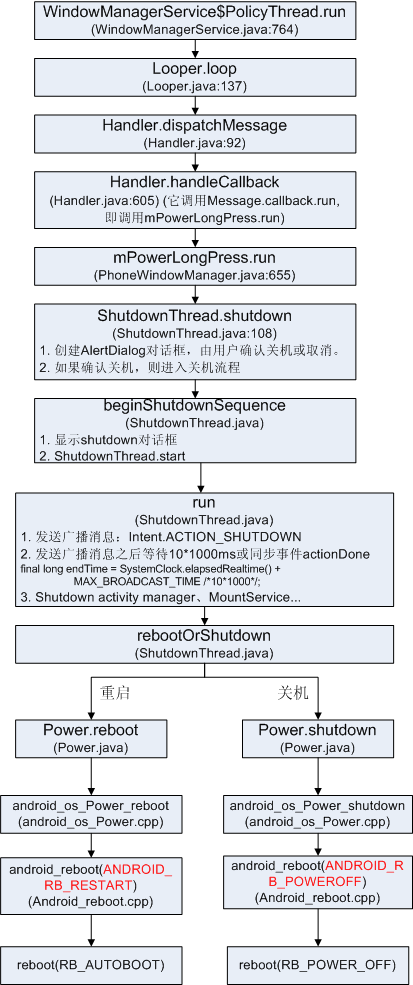Android 中处理POWER/HOME流程
- Android按键消息处理
- 1kernel中同按键相关代码
- 2framework针对键盘事件的处理
- Step1 启动服务
- Step2 InputManagerService创建
- Step3 com_android_server_InputManagerServicecpp
- Step4 NativeInputManager
- Step5 InputManager构造函数
- Step6 将服务运行起来
- Step7 InputManagerServicecppbatuveStart
- Step8 InputManagercpp start
- Step9 InputReaderloopOnce
- Step 10 InputDeviceprocess
- Step 11 KeyboardInputMapperprocess
- Step 12 KeyboardInputMapperprocessKe
- Step 13 consumeRawTouche
- Android中针对按键处理的流程图
- Power短按
- power长按
- reboot and shutdown
- 参考资料
Android按键消息处理
在android系统中,键盘按键事件是由SystemServer服务来管理的;然后在以消息的形式分发给应用程序处理。产生键盘按键事件则是有Linux kernel的相关驱动来实现。
键盘消息有别于其他类型的消息;需要从Linux kernel drivers产生由上层app来处理。同时按键有着不同的映射值,因此从模块独立性角度各个独立的模块应该拥有不同的键盘映射。这样以来,kernel产生的按键事件必然回经过不同的映射才到app。
1、kernel中同按键相关代码
Android 使用标准的 linux 输入事件设备(/dev/input/)和驱动按键定义在 linux 内核include/linux/input.h 中,按键的定义形式如下(仅以BACK HOME MENU POWER为例):

有了按键的定义,就需要产生相应的按键事件了。在kernel/arch/arm/mach-msm/xxx/xxx/xxx.c会对BACK HOME和MENU进行注册。这里使用在屏幕上的坐标来对按键进行区分。这部分代码会在系统启动的时候,将相应的数据存储,以供framework查询。
(这里以xxx代替,是因为针对不同的硬件,需要的Linux kernel不同)

当然从核心板原理图到kernel是属于驱动范畴,不讨论。
2、framework针对键盘事件的处理
上层对输入事件的侦听和分发是在InputManagerService 中实现,首先来看看InputManagerService的创建,
Step1 启动服务
SystemServer.java
class ServerThread extends Thread {
//省略。。
public void run() {
// Create a handler thread just for the window manager to enjoy.
HandlerThread wmHandlerThread = new HandlerThread("WindowManager");
wmHandlerThread.start();
Handler wmHandler = new Handler(wmHandlerThread.getLooper());
//此处省略5k字。。
Slog.i(TAG, "Input Manager");
inputManager = new InputManagerService(context, wmHandler);
}
}可以看到,在系统启动的时候,会首先创建一个系统级别的Handler线程wmHandlerThread用于处理键盘消息(仅说明键盘消息)。然后在创建输入管理服务 inputManager,InputManagerService 的第二个参数就是用于处理按键消息的Handler。
Step2 InputManagerService创建
在往下走到 InputManagerService.java的构造函数。
public InputManagerService(Context context, Handler handler) {
this.mContext = context;
this.mHandler = new InputManagerHandler(handler.getLooper());
mUseDevInputEventForAudioJack =
context.getResources().getBoolean(R.bool.config_useDevInputEventForAudioJack);
Slog.i(TAG, "Initializing input manager, mUseDevInputEventForAudioJack="
+ mUseDevInputEventForAudioJack);
mPtr = nativeInit(this, mContext, mHandler.getLooper().getQueue());
}这里做了重要的两件事情
- 第一:将SystemServer级别的Handler赋值给 InputManagerService自己的消息处理Handler;
- 第二:调用nativeInit继续进行初始化。
Step3 com_android_server_InputManagerService.cpp
static jint nativeInit(JNIEnv* env, jclass clazz,
jobject serviceObj, jobject contextObj, jobject messageQueueObj) {
sp messageQueue = android_os_MessageQueue_getMessageQueue(env, messageQueueObj);
NativeInputManager* im = new NativeInputManager(contextObj, serviceObj,
messageQueue->getLooper());
im->incStrong(serviceObj);
return reinterpret_cast(im);
} 这里nativeInit直接调用了 NativeInputManager的构造函数
Step4 NativeInputManager
NativeInputManager::NativeInputManager(jobject contextObj,
jobject serviceObj, const sp& looper) :
mLooper(looper) {
JNIEnv* env = jniEnv();
mContextObj = env->NewGlobalRef(contextObj);
mServiceObj = env->NewGlobalRef(serviceObj);
{
AutoMutex _l(mLock);
mLocked.systemUiVisibility = ASYSTEM_UI_VISIBILITY_STATUS_BAR_VISIBLE;
mLocked.pointerSpeed = 0;
mLocked.pointerGesturesEnabled = true;
mLocked.showTouches = false;
}
sp eventHub = new EventHub();
mInputManager = new InputManager(eventHub, this, this);
} 这里需要特别注意最后两行代码。第一:创建了 EventHub;第二:创建 InputManager并将 EventHub作为参数传入InputManager。
Step5 InputManager构造函数
InputManager::InputManager(
const sp& eventHub,
const sp& readerPolicy,
const sp& dispatcherPolicy) {
mDispatcher = new InputDispatcher(dispatcherPolicy);
mReader = new InputReader(eventHub, readerPolicy, mDispatcher);
initialize();
}
void InputManager::initialize() {
mReaderThread = new InputReaderThread(mReader);
mDispatcherThread = new InputDispatcherThread(mDispatcher);
} 创建了InputDispatcher 和InputReader,并调用了initialize函数创建了InputReaderThread和InputDispatcherThread。InputDispatcher类是负责把键盘消息分发给当前激活的Activity窗口的,而InputReader类则是通过 EventHub类来实现读取键盘事件的,InputReader实列mReader就是通过这里的 InputReaderThread线程实列mReaderThread来读取键盘事件的,而InputDispatcher实例mDispatcher 则是通过这里的InputDispatcherThread线程实例mDisptacherThread来分发键盘消息的。
到这里,相关的组件都已经被创建了;
Step6 将服务运行起来
接下来看看他们是如何运行起来的。
在systemServer.java中创建inputManager之后。将InputManagerServer进行注册,并运行start()
ServiceManager.addService(Context.INPUT_SERVICE, inputManager);
inputManager.start();
//InputManager的start函数:
public void start() {
Slog.i(TAG, "Starting input manager");
nativeStart(mPtr);
//省略。。
}调用nativeStart继续往下走。顺带说一下,这里的参数mPtr是指向nativeinputmanager service对象的,在InputManagerService构造函数中由nativeInit赋值。
Step7 InputManagerService.cpp–>batuveStart
接下来又到了com_android_server_InputManagerService.cpp中。
static void nativeStart(JNIEnv* env, jclass clazz, jint ptr) {
NativeInputManager* im = reinterpret_cast(ptr);
status_t result = im->getInputManager()->start();
if (result) {
jniThrowRuntimeException(env, "Input manager could not be started.");
}
} 这里的im就是inputManager并且用到了上面传下来的mPtr来重新构建。
Step8 InputManager.cpp start
继续往下则会调用到InputManager.cpp 的start函数
status_t InputManager::start() {
status_t result = mDispatcherThread->run("InputDispatcher", PRIORITY_URGENT_DISPLAY);
if (result) {
ALOGE("Could not start InputDispatcher thread due to error %d.", result);
return result;
}
result = mReaderThread->run("InputReader", PRIORITY_URGENT_DISPLAY);
if (result) {
ALOGE("Could not start InputReader thread due to error %d.", result);
mDispatcherThread->requestExit();
return result;
}
return OK;
}这个函数主要就是分别启动一个InputDispatcherThread线程和一个InputReaderThread线程来读取和分发键 盘消息的了。这里的InputDispatcherThread线程对象mDispatcherThread和InputReaderThread线程对 象是在前面的Step9中创建的,调用了它们的run函数后,就会进入到它们的threadLoop函数中去,只要threadLoop函数返回true,函数 threadLoop就会一直被循环调用,于是这两个线程就起到了不断地读取和分发键盘消息的作用。
Step9 InputReader::loopOnce()
在下来继续看loopOnce()这个函数。
void InputReader::loopOnce() {
//......
size_t count = mEventHub->getEvents(timeoutMillis, mEventBuffer, EVENT_BUFFER_SIZE);
//......
if (count) {
processEventsLocked(mEventBuffer, count);
}
//......
// Flush queued events out to the listener.
// This must happen outside of the lock because the listener could potentially call
// back into the InputReader's methods, such as getScanCodeState, or become blocked
// on another thread similarly waiting to acquire the InputReader lock thereby
// resulting in a deadlock. This situation is actually quite plausible because the
// listener is actually the input dispatcher, which calls into the window manager,
// which occasionally calls into the input reader.
mQueuedListener->flush();
}这里面需要注意像神一样的函数 mEventHub->getEvents()。其实现原理,还有点不是很清楚;但是其功能就是负责键盘消息的读取工作,如果当前有键盘事件发生或者有键盘事件等待处理,通过mEventHub的 getEvent函数就可以得到这个事件,然后交给processEventsLocked 函数进行处理。同样需要特别注意最后一行;后面回解释。我们还会回来的~~~
/*
* Wait for events to become available and returns them.
* After returning, the EventHub holds onto a wake lock until the next call to getEvent.
* This ensures that the device will not go to sleep while the event is being processed.
* If the device needs to remain awake longer than that, then the caller is responsible
* for taking care of it (say, by poking the power manager user activity timer).
*
* The timeout is advisory only. If the device is asleep, it will not wake just to
* service the timeout.
*
* Returns the number of events obtained, or 0 if the timeout expired.
*/
virtual size_t getEvents(int timeoutMillis, RawEvent* buffer, size_t bufferSize)函数原型!
在成功获取input Event之后,就会用到 processEventsLocked函数来处理Event
然后在调用到 processEventsForDeviceLocked(deviceId,rawEvent, batchSize);
最后在void InputDevice::process(constRawEvent* rawEvents, size_t count)
我就在想:问什么不直接到process函数呢?其实我觉得这里体现了设计模式中的单一职责原则;这种设计可以有效的控制函数粒度(有个类粒度,这里自创函数粒度)的大小,函数承担的职责越多其复用的可能性就越小,并且当期中某一个职责发生变化,可能会影响其他职责的运作!
Step 10 InputDevice::process
接下来继续看InputDevice::process函数
void InputDevice::process(const RawEvent* rawEvents, size_t count) {
//。。。。
InputMapper* mapper = mMappers[i];
mapper->process(rawEvent);
}走到这里才算是真真正正的知道了有按键发生了,调用 KeyboardInputMapper::process(const RawEvent*)处理input event; KeyboardInputMapper 继承自 InputMapper。那为什么调用的是 KeyboardInputMapper而不是SwitchInputMapper等等。。
请留意
InputDevice* InputReader::createDeviceLocked(int32_t deviceId,
const InputDeviceIdentifier& identifier, uint32_t classes)函数中的片段:
if (keyboardSource != 0) {device->addMapper(new KeyboardInputMapper(device, keyboardSource, keyboardType));}这里Event Type有必要提一下,以下是一些常用的Event。在kernel/Documentation/input/event-codes.txt中有详细的描述。
- EV_SYN:
- Used as markers to separate events. Eventsmay be separated in time or in space, such as with the multitouch protocol.
- EV_KEY:
- Used to describe state changes ofkeyboards, buttons, or other key-like devices.
- EV_REL:
- Used to describe relative axis value changes,e.g. moving the mouse 5 units to the left.
- EV_ABS:
- Used to describe absolute axis valuechanges, e.g. describing the coordinates of a touch on a touchscreen.
- EV_MSC:
- Used to describe miscellaneous input datathat do not fit into other types.
- EV_SW:
- Used to describe binary stateinput switches.
Step 11 KeyboardInputMapper::process
void KeyboardInputMapper::process(const RawEvent* rawEvent) {
switch (rawEvent->type) {
case EV_KEY: {
int32_t scanCode = rawEvent->code;
int32_t usageCode = mCurrentHidUsage;
mCurrentHidUsage = 0;
if (isKeyboardOrGamepadKey(scanCode)) {
int32_t keyCode;
uint32_t flags;
if (getEventHub()->mapKey(getDeviceId(), scanCode, usageCode, &keyCode, &flags)) {
keyCode = AKEYCODE_UNKNOWN;
flags = 0;
}
processKey(rawEvent->when, rawEvent->value != 0, keyCode, scanCode, flags);
}
break;
}
}
}在这里,先判断isKeyboardOrGamepadKey(scanCode),然后在用getEventHub()->mapKey()检测 提供的key是否正确,在然后就开始处理了processKey
Step 12 KeyboardInputMapper::processKe
void KeyboardInputMapper::processKey(nsecs_t when, bool down, int32_t keyCode,
int32_t scanCode, uint32_t policyFlags) {
//忽略到所有的。。只看最后两行。。
NotifyKeyArgs args(when, getDeviceId(), mSource, policyFlags,
down ? AKEY_EVENT_ACTION_DOWN : AKEY_EVENT_ACTION_UP,
AKEY_EVENT_FLAG_FROM_SYSTEM, keyCode, scanCode, newMetaState, downTime);
getListener()->notifyKey(&args);
}不用多解释了,直接notifyKey了。。但需要注意,这里的notifyKey 仅仅是 NotifyKeyArgs push到消息队列中去;并没有通知上层!那到底在那儿通知的呢?
还记不记得在void InputReader::loopOnce()这个函数的最后一行代码,其实质是在这个函数中通知上层有按键事件发生。

这个flush()很明显,notify了之后,就delete,不存在了。问什么不是在getListener()->notifyKey(&args);的时候就真正的notify?我觉得可以做如下角度予以考虑:
- 第一:线程是最小的执行单位;因此每当inputThread.start()的时候,如果不flush,回造成数据混乱。
- 第二:flush操作是必须的,同时在loopOnce的最后操作也是最恰当的。其实这里的Listener也就是充当了一个事件分发者的角色。
这说明,到这里已经完全识别了按键了,并按照自己的键盘映射映射了一个值保存在args中,notifyKey给上层应用了。。
Step 13 consumeRawTouche
其实针对BACK HOME MENU这三个按键来说,其实质就是TouchScreen;因此在inputReader.cpp中获取Touch映射是在函数boolTouchInputMapper::consumeRawTouche**s(nsecs_t when, uint32_t policyFlags) 中。这里同上面的**Step 12相同。
首先检测不是多点Touch。然后使用const TouchInputMapper::VirtualKey*TouchInputMapper::findVirtualKeyHit( int32_t x, int32_t y)依据坐标值查找出Touch的映射值。
到最后了啊。。。
呵呵,看看是怎么实现的。。

Android中针对按键处理的流程图
这里使用针对power按键为例进行说明
Power短按
power长按
reboot and shutdown
参考资料
Android4.x 如何处理Power按键
Android Framework层Power键关机流程



